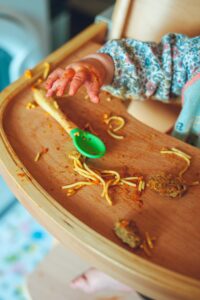Freedom Within Limits
The idea of giving freedom to babies and toddlers may send chills down caregivers’ spines. Wouldn’t freedom mean toddlers who eat nothing but candy and spend hours watching movies all day? Or children who leave the house in shorts when it’s freezing outside? Not quite. Freedom within limits in Montessori means giving children the level of independence they’re prepared for (but not more.) Here, we’ll discuss where this principle comes from and how parents and caregivers can apply it at home.
Why Children Need Freedom Within Limits
Dr. Montessori believed that leaving a child “free in his movements and in his experiences” helps keep alive their natural enthusiasm for knowledge. Freedom in education, then, doesn’t just help children learn — it helps them develop a lifetime love of learning.
“Let us leave the life free to develop within the limits of the good,” Dr. Montessori wrote, “and let us observe this inner life developing.” She taught that adult intervention in the process of a child’s growth should be indirect. The adult’s role should simply be to prepare the means necessary for a child’s development and then wait for the process to unfold in its own perfect time and way.
“The greatest help you can give your children is the freedom to go about their own work in their own way, for in this matter your child knows better than you,” Dr. Montessori wrote.
Children need freedom to fulfill their potential and develop into adults. “It is only through freedom and by experiences upon the environment that man can develop,” Dr. Montessori wrote in “The Absorbent Mind.” Giving children freedom helps them learn how to make decisions for themselves.
Despite the importance of freedom, limits are also important. Montessori circles often quote Dr. Montessori’s words to “follow the child.” But that’s not the entirety of her quote. “Follow the child,” she wrote, “but follow the child as his leader.”
 Children need limits set by adults who are confident enough to follow through with limits and boundaries. It may seem counterintuitive, but boundaries provide children with more freedom, not less. Parenting expert Janet Lansbury wrote that “Too much freedom actually makes our children feel the opposite of free.”
Children need limits set by adults who are confident enough to follow through with limits and boundaries. It may seem counterintuitive, but boundaries provide children with more freedom, not less. Parenting expert Janet Lansbury wrote that “Too much freedom actually makes our children feel the opposite of free.”
When children know that adults will keep them physically and emotionally safe through limits, they have the freedom to explore, discover, and create without fear. That’s the importance of offering freedom within limits in Montessori.
Examples of Freedom Within Limits in Montessori
Freedom within limits in Montessori environments will look different for everyone, as every family has different customs and routines. In everything you do, you can ask yourself, “How can I give my child freedom in this process? And what limits am I responsible for setting and maintaining?” Below are just a few ideas to get you started.
Self-Dressing
Consider giving your child freedom to dress themselves. Giving your child this freedom empowers them with confidence and helps them develop autonomy. This process starts with letting them choose what clothing to wear. Limit the options to clothing you’d feel comfortable with your child wearing. Doing so sets your child up for success and makes it less likely you will need to tell them to change their outfit (and diminish their confidence and independence in the process).
Pre-verbal children or babies may look or gesture toward the outfit they’d prefer to wear if you show them two choices. You can ask them for help pushing their arms through the sleeves or lifting their legs to put pants on. As children grow, you can provide them with accessible choices that are appropriate for the weather and occasion. Eventually, they will take more initiative in dressing themselves.
Your children may choose outfits that you perceive as mismatched or tacky. Do your best to remember that a confident child is more important than a perfectly dressed one. As you shop for clothing, be mindful to choose options that are child-friendly. Wide-necklines, clasp buttons, and loose-fitting pants can make the process easier for children.
During Mealtimes
 The mealtime division of responsibility is a perfect example of freedom within limits. It is the parent’s responsibility to provide healthy, balanced meals at regular times. Parents should always be the ones to decide what food is served. It is the child’s responsibility to decide what and how much to eat. It’s best to avoid bribing a child to eat or using food as a reward or punishment. Instead, we should trust that our children know their bodies best. With this approach, children are given freedom over what they eat while still benefiting from appropriate, adult-set limits.
The mealtime division of responsibility is a perfect example of freedom within limits. It is the parent’s responsibility to provide healthy, balanced meals at regular times. Parents should always be the ones to decide what food is served. It is the child’s responsibility to decide what and how much to eat. It’s best to avoid bribing a child to eat or using food as a reward or punishment. Instead, we should trust that our children know their bodies best. With this approach, children are given freedom over what they eat while still benefiting from appropriate, adult-set limits.
This division of mealtime responsibility, which Ellyn Satter has popularized, is backed by numerous studies. When we trust our children and give them the freedom to listen to their bodies, they develop healthy habits and a positive relationship with food.
Discipline
Many parents may wonder how to “get” their children to stop tantruming, protesting, or crying. The answer? You don’t. Children should have complete freedom to express their feelings, whether they be positive or negative. Children will have feelings of anger, sadness, and disappointment no matter what. Discouraging these feelings doesn’t prevent them from coming, but it does keep your child from learning how to process and communicate them. Avoid minimizing your children’s experiences, telling them they’re fine when they’re upset, or trying to distract them from how they feel.
Accepting all feelings does not mean accepting all behaviors. While children should have complete freedom to express themselves, there should be limits in place to keep the behaviors safe. As a parent, it’s your job to make sure your family is safe, even amid strong feelings. For example, if your child wants to play with you and feels upset that you’re feeding the baby, you should allow (and even encourage) them to express their feelings. However, you should not allow your child to hit the baby as a result of their anger.
Principles of positive parenting can help you maintain appropriate boundaries in your home without punishment, shame, or fear.
Freedom Within Limits in Your Home
We’ve barely scratched the surface of what it looks like to apply the principle of freedom within limits in Montessori homes. There are countless ways to offer freedom within limits at home, and opportunities to do so will be clear as we take the time to carefully observe our children and our routines. What does this Montessori principle look like in practice in your home? Comment below and let us know!





Excellent reading materials